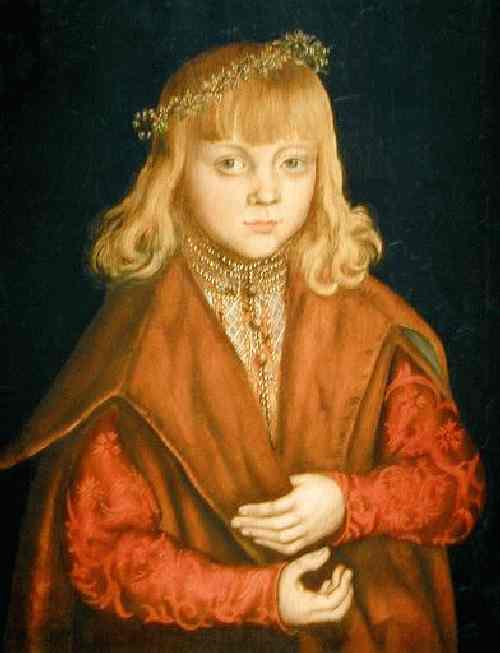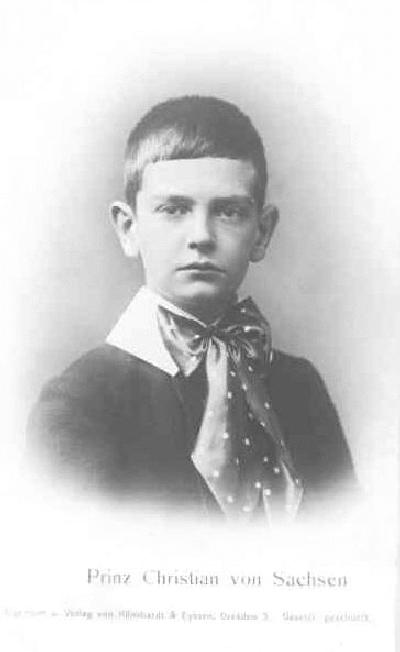
Figure 1.--This Saxon prince was painted in 1517. It may be the son of Frederick III. A companion piece was made of the boys's sister at the same time. National Gallery of Art, Washington, D.C.


Figure 1.--This Saxon prince was painted in 1517. It may be the son of Frederick III. A companion piece was made of the boys's sister at the same time. National Gallery of Art, Washington, D.C. |
In the sixth century AD present-day Saxony was settled by Sorbian tribes. The rule of the House of Wettin, which began in 1089 when Heinrich von Eilenburg became Margrave of Meissen, went on to last for 829 years.
Saxony in 1485 the land was divided between the brothers Albert and Ernst. Albert took the eastern territories, largely corresponding to the present-day federal state of Saxony.
A painting exists entitled "Portrait of a Saxonian Prince", which was done by Lucas Cranach of the German School. He lived from 1472 to 1553. It pictures a young robed boy waering what look likes a luxurious red silk tunic. He wears a crown of flowers on his head. He may be the son of Frederick III, we need to investiagte this.
In 1697 Augustus the Strong, Elector of Saxony, was crowned King of Poland. Under the rule of Friedrich August I (Augustus the
Strong) and Friedrich August II, Dresden became a centre of European art and culture.
Saxony fought on the side of Napoleon at the Battle of Leipzig and lost. As a result, substantial territories had to be ceded to Prussia. Early industrialisation at the end of the 19th century brought prosperity but also social tension to Saxony. In Leipzig Ferdinand Lassalle founded the Allgemeiner Deutscher Arbeiterverein (General German Workers’ Association), and in Chemnitz August Bebel founded the Sächsische Volkspartei (Saxon People’s Party), from which the Social Democratic Party later emerged.
King John of Saxony was born in 1801. His father was Duke Maximilian of Saxony (1759- ). His mother was Caroline (Bourbon) of Parma (1770- ). They had four children. Both Albert (1828-1902) and George (1832-1904) were to succeed their father as kings of Saxony. The other two children were Anna (1836- ) and Margaret (1840). John acceded in 1854 and was kaised from a duke to a king. He died in 1873.
Albert (of Saxony) (1828-1902), king of Saxony (1873-1902), noted for his military ability. At the age of 21, he served as a captain in the army of the duchies of Schleswig and Holstein in their war against the Danes. He married Caroline Frederica Francisca (Vasa) in 1853. They had no children. Albert in 1866, during the Austro-Prussian War (also called the German Civil or Seven Weeks War) commanded a Saxon corps, which distinguished itself at the decisive Battle of Königgrätz by a firm stand against the Prussians. In the
Franco-Prussian War of 1870-1871, in which Saxony (Sachsen) fought on the side of Prussia and the other German states, Albert commanded the Saxon army that helped defeat the French at Gravelotte, France. He was
then placed in command of the so-called Fourth Army, which
fought at Sedan, France, and took part in the siege of Paris. After the armistice, Albert commanded the German army that occupied France, and upon the declaration of peace he became an inspector general and field marshal of the German army. During his reign, Albert encouraged industrialization and administrative reforms.
King George was born in Pillnitz during 1832. His father was King John of Saxony (1801- ). I do not know whomis mother was. He married Maria Anna of Saxe-Coburg-Gotha in Lisbon during 1859. They had three children: Frederick Augustus III (1865-1832), Maria Josepha (1867- ), and Johann George (1869- ). Maria Josepha married Grand Duke Otto (Habsburg-Lotharingen) of Austria in 1886. Their only child Emperor Karl I, the last Emperor of Austria. King George acceded to the throne late in life on the death of his older brother Albert and only ruled for 2 years before dieing in Pillnitz during 1904.

Figure 2.--This is Prince Christain von Sachsen (Christian of Saxony). We are not sure, however, who his parents were and how he fitted in to the Saxon royal family. We are not sure precisely when this portrait was taken. The coding to the image suggests about 1894. |
The last king of Saxony was Friedrich August III. He was born in 1865 and acceded to the throne in 1904. His father was King George of Saxony (1832- ). His mother was Maria Anna of Saxe-Coburg-Gotha (1843- ). He married Louise Habsburg-Lotharingen in 1891, but they divorced in 1903. They had one child, Prince Ernest Henry (Werrin) of Saxony (1896- ). He married Sophie von Nassau in 1921 and they had three children. Friedrich-August was deposed on November 12, 1918 in the aftermath of World War I. When the deposed king journeyed through Saxony after the 1918 revolution, Saxon people waved to him at railway stations. Whereupon the deposed king is supposed to have said in broad Saxon dialect: "You’re a fine lot of Republicans." He died in 1932. Saxony and other German states still had broad power within the Weimar Republic, but with the NAZIs seizure of power state authority was centraliized. After the NAZI defeat in World War II, Saxony fell within the Soviet zone of occupation and until unification in 1989 was a part of the German Democratic Republic (DDR), East Germany.
Navigate the Boys' Historical Clothing Web Site royal pages:
[Main German royal page]
[Main royal pages]
[Austria]
[Belgium]
[Denmark]
[France]
[German Empire]
[Italy]
[Luxenburg]
[Monaco]
[Netherlands]
[Norway]
[Romania]
[Russia]
[Spain]
[United Kingdom]
